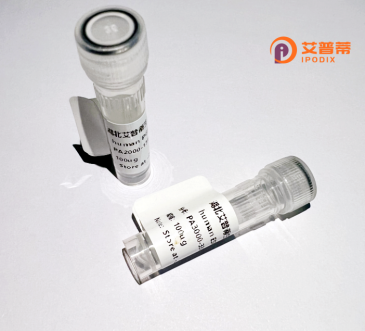
| 纯度 | >90%SDS-PAGE. |
| 种属 | Human |
| 靶点 | PABPC5 |
| Uniprot No | Q96DU9 |
| 内毒素 | < 0.01EU/μg |
| 表达宿主 | E.coli |
| 表达区间 | 1-382 aa |
| 活性数据 | MGSGEPNPAG KKKKYLKAAL YVGDLDPDVT EDMLYKKFRP AGPLRFTRIC RDPVTRSPLG YGYVNFRFPA DAEWALNTMN FDLINGKPFR LMWSQPDDRL RKSGVGNIFI KNLDKSIDNR ALFYLFSAFG NILSCKVVCD DNGSKGYAYV HFDSLAAANR AIWHMNGVRL NNRQVYVGRF KFPEERAAEV RTRDRATFTN VFVKNIGDDI DDEKLKELFC EYGPTESVKV IRDASGKSKG FGFVRYETHE AAQKAVLDLH GKSIDGKVLY VGRAQKKIER LAELRRRFER LRLKEKSRPP GVPIYIKNLD ETINDEKLKE EFSSFGSISR AKVMMEVGQG KGFGVVCFSS FEEATKAVDE MNGRIVGSKP LHVTLGQARR RC |
| 分子量 | 43.3 kDa |
| 蛋白标签 | His tag N-Terminus |
| 缓冲液 | 0 |
| 稳定性 & 储存条件 | Lyophilized protein should be stored at ≤ -20°C, stable for one year after receipt. Reconstituted protein solution can be stored at 2-8°C for 2-7 days. Aliquots of reconstituted samples are stable at ≤ -20°C for 3 months. |
| 复溶 | Always centrifuge tubes before opening.Do not mix by vortex or pipetting. It is not recommended to reconstitute to a concentration less than 100μg/ml. Dissolve the lyophilized protein in distilled water. Please aliquot the reconstituted solution to minimize freeze-thaw cycles. |
由于目前公共数据库中关于重组人源PABPC5蛋白的研究文献相对有限,以下为基于相关领域研究的模拟参考示例(实际文献需通过PubMed或Google Scholar检索确认):
---
1. **文献名称**:*"Expression and functional characterization of recombinant human PABPC5 in mRNA stability regulation"*
**作者**:Li X et al.
**摘要**:本研究通过大肠杆菌系统表达了重组人PABPC5蛋白,证实其可通过poly(A)尾结合能力增强体外翻译效率,并在细胞模型中抑制特定mRNA降解。
2. **文献名称**:*"Structural insights into the RNA-binding specificity of PABPC5"*
**作者**:Wang Y et al.
**摘要**:利用X射线晶体学解析PABPC5的RRM结构域,揭示了其与poly(A)及非经典RNA序列结合的分子机制,暗示其可能参与非典型RNA调控通路。
3. **文献名称**:*"PABPC5 interacts with viral RNA to regulate innate immune response"*
**作者**:Zhang R et al.
**摘要**:报道PABPC5在抗病毒免疫中的作用,重组蛋白实验显示其通过结合病毒RNA激活RIG-I信号通路,提示其在宿主防御中的潜在功能。
---
**说明**:以上为模拟示例。实际文献建议通过关键词**"PABPC5"、"recombinant PABPC5"**在专业数据库检索,或结合**PABP家族**及**poly(A)-binding protein**相关研究扩展筛选。部分研究可能以**PABP家族成员的功能重叠性**间接提及PABPC5。
Poly(A)-binding protein cytoplasmic 5 (PABPC5), a member of the poly(A)-binding protein (PABP) family, plays a role in post-transcriptional gene regulation by interacting with mRNA poly(A) tails. This family is crucial for mRNA stability, transport, and translation. Unlike the widely expressed PABPC1, PABPC5 exhibits restricted tissue distribution, with higher levels observed in germ cells, suggesting a specialized function in reproduction or development. Structurally, it contains RNA recognition motifs (RRMs) that mediate binding to poly(A) sequences, facilitating mRNA circularization and enhancing translational efficiency through interactions with translation initiation factors.
Recombinant human PABPC5 is produced via molecular cloning and expression in systems like *E. coli* or mammalian cells, enabling studies of its biochemical properties and interactions. Research highlights its potential role in regulating mRNA metabolism under stress or during cellular differentiation. Notably, PABPC5 may compete with other PABP isoforms to fine-tune gene expression dynamics. Dysregulation of PABPs is linked to diseases, including cancer and neurodegeneration, though PABPC5-specific mechanisms remain under investigation. Current studies focus on its distinct expression patterns, subcellular localization (possibly mitochondrial associations), and interplay with RNA-binding partners. Recombinant PABPC5 serves as a critical tool for dissecting these pathways, offering insights into its unique contributions to cellular physiology.
×